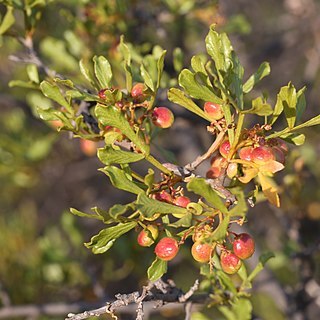Glabrous; branchlets angulate; leaves longish-stalked; leaflets sessile, obovate, tapering to tlte base, acute, obtuse, or emarginate, mucronulate, with undulate-denticulate margins, or incised, 5-7 dentate, glossy above, parallel-veined on both surfaces; panicles axillary and terminal, equalling the leaves or longer; drupe globose, glabrous. Very similar to R. lucida, of which it has the habit, but the leaves are longer-stalked, the leaflets thinner, smaller and undulate, mostly dentate, and the panicles longer. From the preceding it is distinguished by the glabrous, resinous, shining, long-stalked leaves. Branchlets patent. Petiole ^-i inch long, winged. Leaflets membranaceous, with pellucid veins, wedge-shaped, obtuse, or sub-acuminate, 1-1 (2/4) inches long, 6-10 lines wide, the lateral ones smaller and more oval. Male panicle 3-4 inches long, lower branches 1.5-2 uncial; pedicels capillary; female or hermaphrodite panicles shorter and less compound. Drupe shining, sub-compressed, the size of a small pea.
Glabrous; branchlets angulate or two-edged; leaves petiolate; leaflets sessile, cuneate-oblong or obovate-oblong, obtuse, acute, or emarginate, flat, quite entire, ribbed on both surfaces, paler beneath, sub-coriaceous; panicles terminal, somewhat longer than the leaves; drupe globose, glabrous. Shrub grey or brown, erect, with rigid branches. Petioles winged, particularly in the upper part. Leaflets of var. 8-10 lines long, 3-4 lines wide; in var y. 1-1 (1/4) inch long, 6 lines wide; in var. y. 1-1 (1/4)y. inch long, 5-6 lines wide; lateral leaflets smaller, somewhat patent, oblong. Panicles terminal, rarely axillary, many-flowered, the male ones longer. Flowers minute. Drupe white, shining, somewhat compressed, the size of a small pea. Differs from the preceding by the 3 times smaller, not undulate or incised-toothed leaflets.
Quite glabrous; branchlets spinescent, as well as the stalked leaves, resinous, shining; leaflets lanceolate, sub-carinate, undulate, with a short, recurved or twisted acumen, cuneate at base; panicles terminal, glabrous. Habit of the preceding, differing by the shining, undulate, shorter leaflets. Leaves sometimes fasciculate; some of them 1 or 2 foliolate, sessile, the others stalked, perfect, 3-foIiolate. Intermediate leaflet about 6 lines long, 1.5 line wide, with quite entire, undulate margins, uninerved, few-veined beneath; lateral leaflets similar but smaller. Petioles 4-6 lines long, carinate, subulate. Panicle uncial, with patent branches. Flowers very minute.
Shrub, 0.5-3.0 m high; evergreen, much branched, multi-stemmed; bark grey-brown, smooth to granular; branches dark brown, spreading; branchlets ribbed, sometimes ending in spines. Leaves aromatic when crushed, petiolate, trifoliolate; leaflets sessile, membranous, olive-green, young leaves often glutinous, oblanceolate to obovate, margins entire to irregularly crenate in upper half and apex. Inflorescence axillary and terminal panicles; terminal exposed, much branched, minutely flowered. Flowering time all year. Fruit a drupe, oblate, ellipsoid, glabrous, shiny, dull yellow to cream-coloured.
An evergreen shrub or small tree. It has several stems. The leaves have a scent. The bark has spines. The bark is grey and smooth. It grows up to 3-5 m high. The leaves are divided into 3 small leaflets. The edges of the leaves are wavy. The flowers are small and green or cream. They are in heads 5 cm long in the axils of leaves or near the ends of branches. The fruit are shiny and green but turn red when ripe. They are round and 5-6 mm across.
Dioecious, many-stemmed, evergreen shrub, up to 3 m tall, with spinous branchlets (except in SW Cape). Leaves trifoliolate, leaflets sessile, oblanceolate, olive-green, sticky, aromatic. Flowers yellowish. Drupe lens-shaped, shiny, dull yellow to cream-coloured.
Dioecious, evergreen shrub to 3 m. Leaves trifoliolate, leaflets sessile, oblanceolate, sticky, aromatic. Flowers yellowish. Drupes lens-shaped, shiny.


